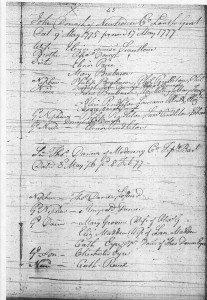Sir William Betham (1779-1853) was appointed deputy Ulster King of Arms in 1807 and Ulster King of Arms in 1820. Betham spent a lifetime collating indexes and abstracts of the manuscripts held in the Record Tower of Dublin Castle. Although Betham was a polymath, it is his work in the Records Tower for which Irish genealogists and family historians are most grateful.

During his lifetime Betham consistently lobbied the Government to fund and build a Public Records Office to house its manuscripts. Somewhat ironically, this was done several years after Betham’s death. Much of the material from which Betham’s abstracts were taken were stored in the Public Records Office (PRO), which was subsequently severely damaged by fire in 1922. As a results it is Betham’s Genealogical Abstracts that have survived rather than the original manuscripts.
The majority of wills and administrations proved in Ireland prior to ca. 1900 were destroyed in the PRO in 1922 and as a result the genealogists is left to rely on substitutes and abstracts. Numbered amongst these are Sir William Betham’s Abstracts of Wills and Administrations.
The original notebooks containing Betham’s Genealogical Abstracts as well as the microfilms of these are held at the National Archives of Ireland and are not currently available online. In making his abstracts, Betham was solely concerned with the genealogical material contained in the Prerogative wills and administrations.
Betham’s Genealogical Abstracts contain the following material:
Prerogative wills – As early as 1538, indexed from 1700 to 1799/1800
Prerogative Administrations/Intestate 1595-1800
Prerogative Marriage Licences 1629-1801
Dublin Marriage Licences 1660-1824
Wills for the Diocese of Kildare A-S 1661-1826
Sir Arthur Vicars (1864-1921), one of Betham’s successors as Ulster King of Arms, published in 1897 the Index to the Prerogative Wills of Ireland, 1536-1810. This index, was compiled from Betham’s Genealogical Abstracts, and as such can be viewed as the index to Betham’s Prerogative Wills Abstracts if not the other material contain in the collection.
The illustration from one of Betham’s Prerogative Wills notebooks from 1775 shows the nature of the material that can be found in the abstracts. In the instance of John Donaghy, Betham’s Abstract includes the name and address of the testator; the date of the will and the date that the will was proved and the names of the beneficiaries of the will and how they were related to the testator; in the case of John Donaghy, the beneficiaries included his wife – her maiden name is also recorded – a brother, sister, nephews, nieces, grandnephews and grandnieces. Although it might be a bit of presumption, the absence of children from the abstract might indicate that John Donaghy died without issue.
A subsequent blog will deal with Sir William Betham’s Pedigree Charts that were drawn-up using the material he had collected in his Genealogical Abstracts.
